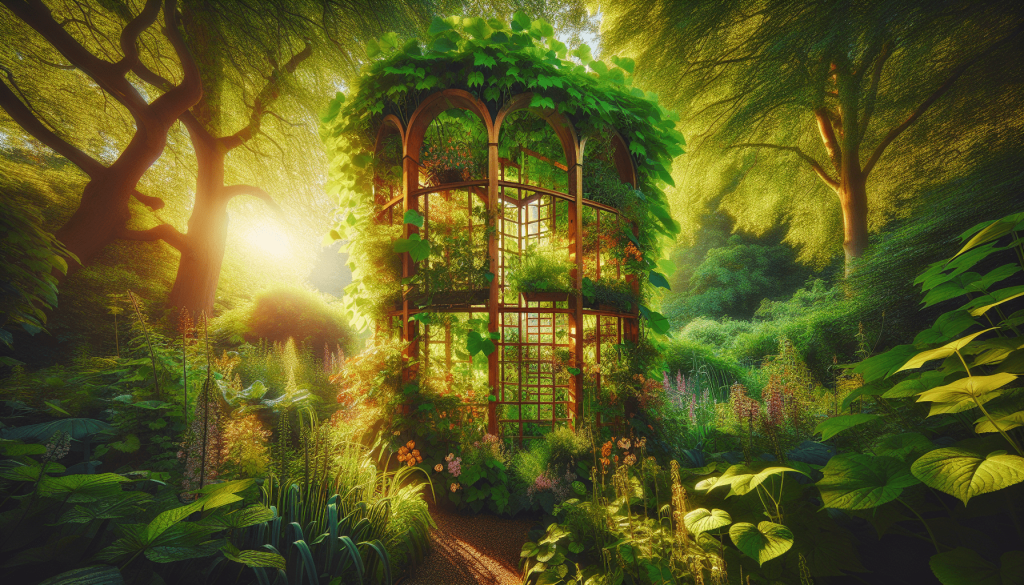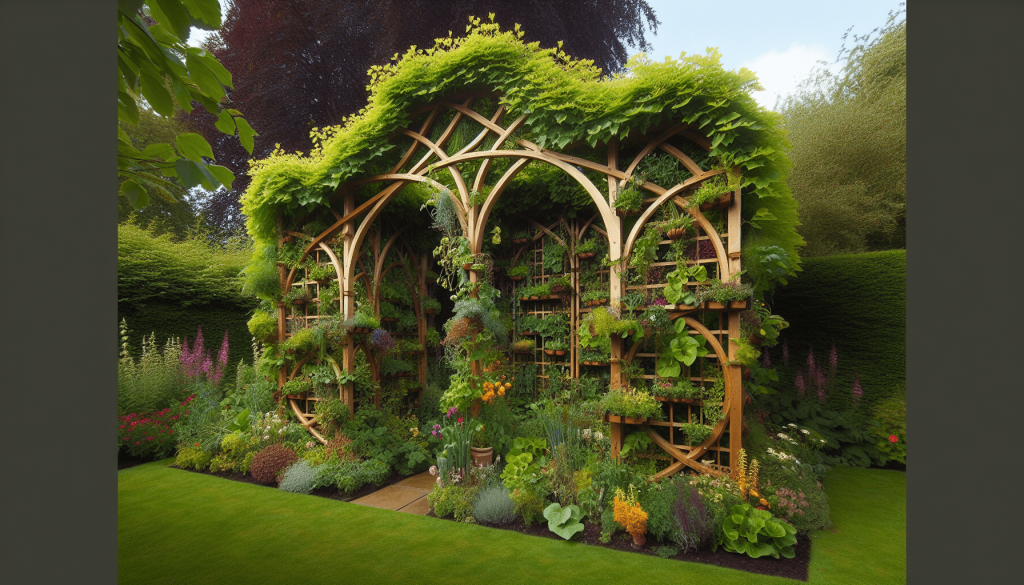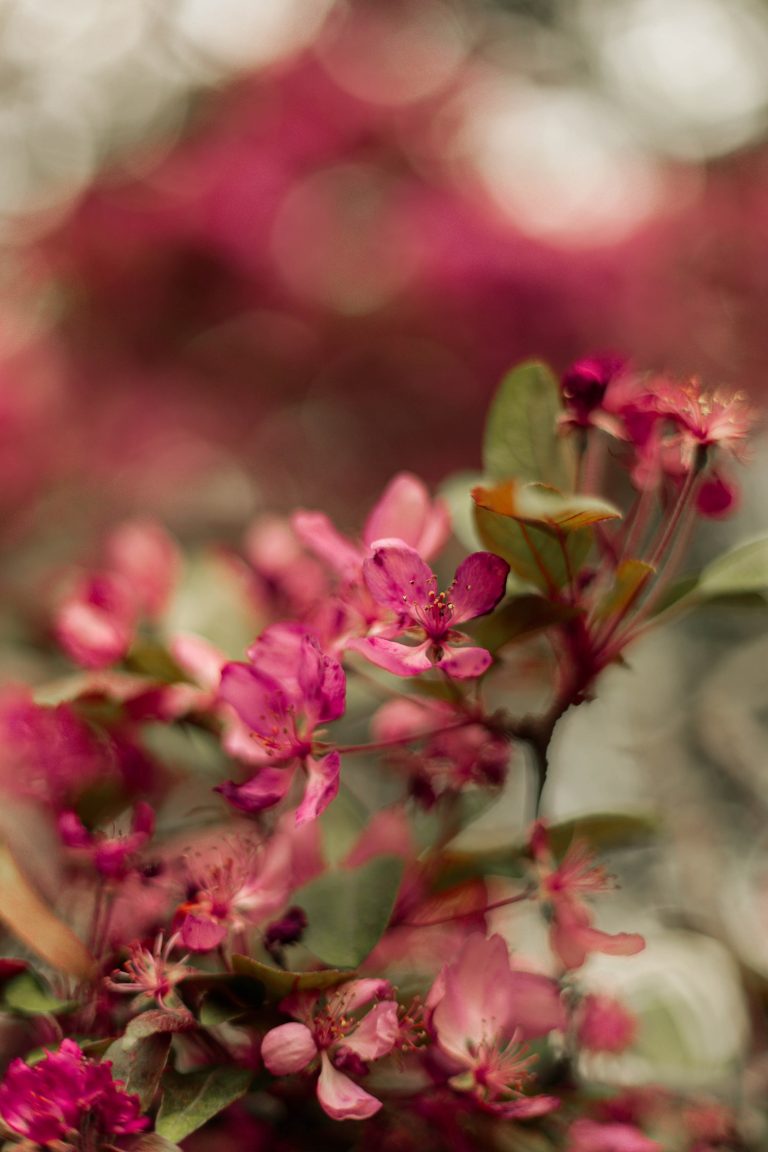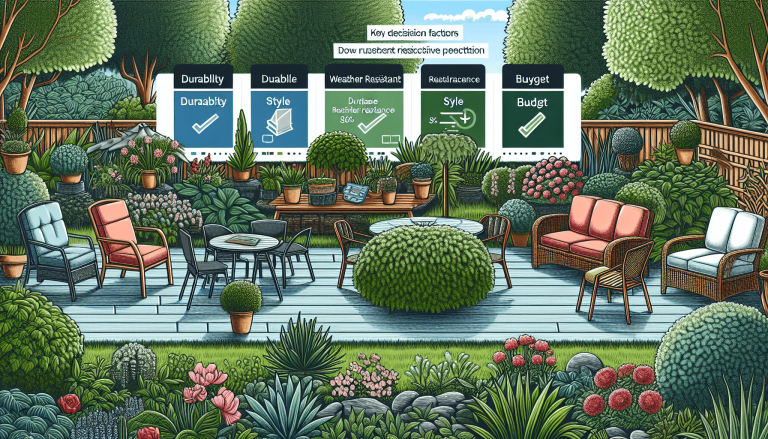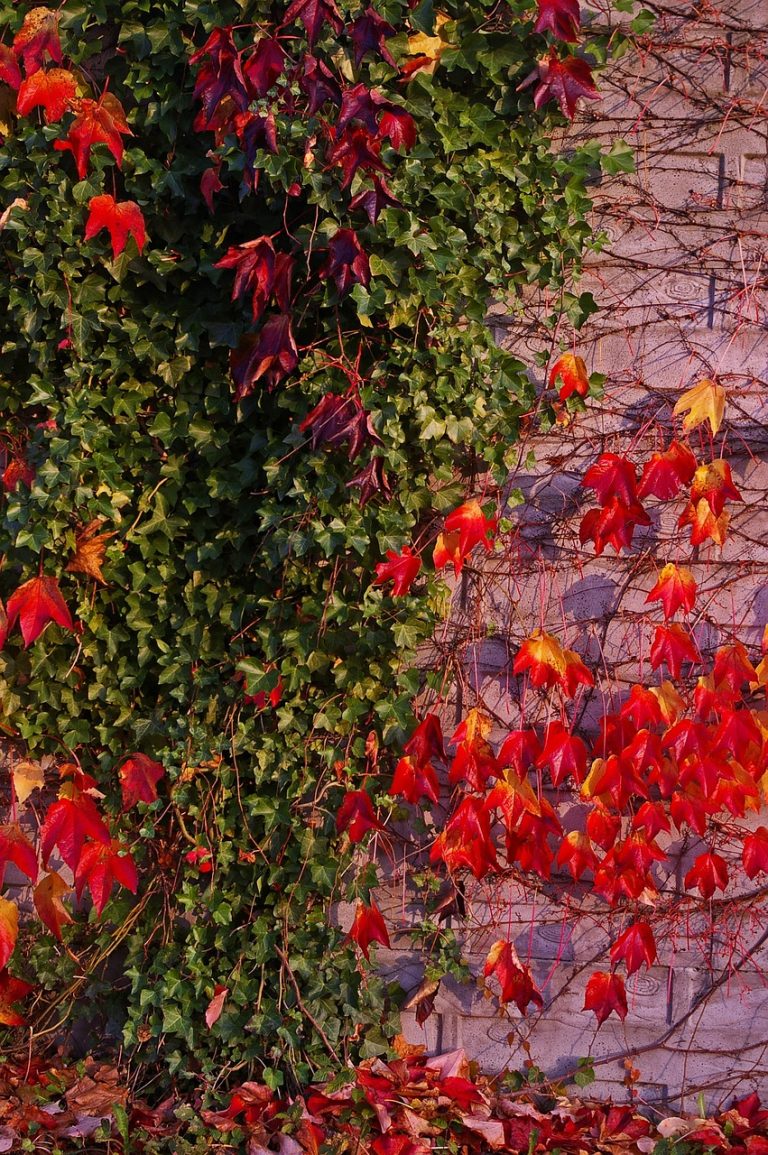If you’re looking to add a touch of charm and vertical beauty to your garden, then building a DIY trellis or arbor for climbing plants is the perfect project for you. Whether you have a small balcony or a sprawling backyard, this article will guide you through the steps of creating your very own trellis or arbor. With easy-to-follow instructions and helpful tips tailored specifically for the UK climate, you’ll soon be able to enjoy a lush and flourishing display of climbing plants that will enhance the aesthetic appeal of your outdoor space. So grab your tools and get ready to embark on a fulfilling DIY adventure that will transform your garden into a botanical haven.
Table of Contents
ToggleChoosing the Right Location
Considering sunlight exposure
When choosing a location for your trellis or arbor, it’s important to consider the sunlight exposure. Most climbing plants thrive in full sunlight, so look for a spot in your garden that receives at least six hours of direct sunlight each day. Take note of any nearby trees or buildings that may cast shadows and block the sunlight. By ensuring your trellis or arbor is placed in a sunny location, you will provide the ideal conditions for your climbing plants to flourish.
Assessing wind conditions
In addition to sunlight exposure, it’s crucial to assess the wind conditions in your chosen location. Climbing plants often require some support when it comes to wind resistance, so selecting a sheltered spot will prevent your trellis or arbor from being damaged. Pay attention to the direction of prevailing winds in your area and try to find a spot that is protected from strong gusts. Keep in mind that while some plants can tolerate windy conditions, others may struggle to thrive if constantly exposed to strong winds.
Selecting the Materials
Wood
Wood is a popular choice for building trellises and arbors due to its natural beauty and versatility. There are various types of wood that can be used, such as cedar, pine, or redwood. Cedar, in particular, is highly durable and resistant to rot and insect damage. When selecting wood for your project, make sure to choose treated or naturally resistant wood to ensure its longevity. Keep in mind that wood will require regular maintenance, such as staining or sealing, to protect it from the elements and extend its lifespan.
Bamboo
For a more exotic and eco-friendly option, consider using bamboo for your trellis or arbor. Bamboo is a fast-growing and sustainable material that adds a unique and tropical touch to your garden. It is lightweight, flexible, and resistant to pests and rot. However, it’s important to choose the right type of bamboo that is suitable for structural purposes. Look for thick-walled varieties that are more sturdy and less likely to split or break under pressure. Remember to regularly inspect and treat bamboo structures to prevent any potential issues.
Metal
If you prefer a modern or contemporary look, metal trellises and arbors are a great option. Metal provides durability and strength, making it suitable for supporting heavy climbing plants. There are different types of metal to choose from, such as wrought iron, steel, or aluminum. Wrought iron adds a touch of elegance and can be intricately designed, while steel and aluminum offer a more minimalist and sleek appearance. When using metal, ensure it is treated or coated to prevent rusting, especially in areas with high levels of moisture.
Measuring and Planning
Determining the size and height
Before starting your DIY project, it’s essential to determine the size and height of your trellis or arbor. Consider the available space in your garden and the growth patterns of your chosen climbing plants. Ensure the dimensions of your structure allow enough room for the plants to spread out and grow properly. The height should also accommodate the maximum height of your climbers. Take into account any local regulations or restrictions that may apply, such as height limitations or distance from property lines.
Sketching a design
Once you have decided on the size and height, it’s time to sketch a design for your trellis or arbor. This step allows you to visualize the final product and make any necessary adjustments before construction. Consider the overall style and aesthetics you want to achieve, whether it’s a traditional or contemporary look. Think about the shape, patterns, and decorative elements you want to incorporate. Sketching the design will help guide you through the construction process and ensure that you create a trellis or arbor that meets your vision.
Building a Trellis
Preparing the ground
Before building your trellis, it’s important to prepare the ground where it will be installed. Clear the area of any grass, weeds, or debris. Level the ground and remove any rocks or roots that may interfere with the construction process. By ensuring a clean and stable base, you will lay the foundation for a sturdy and long-lasting trellis.
Digging post holes
Next, it’s time to dig post holes for your trellis. The number of posts will depend on the design and size of your structure. Use a post hole digger or shovel to create holes that are at least one-third of the length of your posts. Make sure the holes are evenly spaced and aligned according to your design plan. It’s advisable to dig the holes slightly deeper than necessary to allow for adding gravel or concrete for added stability.
Installing the posts
Once the post holes are ready, it’s time to install the posts. Place the posts carefully into the holes, ensuring they are straight and level. Use a level tool to check the vertical alignment of each post. You may need to add or remove soil to achieve the desired height. Once the posts are in position, backfill the holes with soil, tamping it down firmly to secure the posts in place.
Attaching the cross members
After the posts are securely installed, it’s time to attach the cross members of your trellis. These horizontal pieces will provide support for the climbing plants to grow and intertwine. Measure and cut the cross members according to your design specifications. Use screws, nails, or brackets to attach the cross members to the vertical posts, ensuring they are evenly spaced and aligned. Double-check the stability and adjust as necessary before proceeding with the next steps.
Constructing an Arbor
Building the frame
To construct an arbor, start by building the frame. The frame serves as the main structure and support for the arched top and side trellises. Measure and cut the necessary pieces of wood or metal according to your design. Assemble the frame using screws, nails, or bolts, ensuring that all joints are secure. Double-check the stability and make any necessary adjustments before proceeding.
Adding supporting beams
Once the frame is assembled, it’s time to add supporting beams. These horizontal or diagonal beams provide additional stability and support to the arbor. Measure and cut the beams according to your design and attach them to the frame using screws, nails, or brackets. Ensure they are evenly spaced and aligned to create a sturdy structure that can withstand the weight of the climbing plants.
Attaching the arched top
The arched top is the defining feature of an arbor. Measure and cut the necessary pieces of wood or metal to create the arched shape. Securely attach the arched top to the frame and supporting beams, ensuring it is centered and level. Avoid over-tightening the screws or nails to prevent damaging the wood or metal. Double-check the stability and adjust as necessary, ensuring the arch is secure and visually appealing.
Installing side trellises
To enhance the functionality and aesthetics of your arbor, consider installing side trellises. These additional structures provide extra support for climbing plants and create a visually pleasing backdrop. Measure and cut the necessary pieces of wood or metal for the side trellises. Attach them securely to the vertical posts or frame, ensuring they are level and evenly spaced. Take into consideration the growth patterns of your chosen climbing plants and provide adequate space for them to thrive.
Choosing and Preparing Climbing Plants
Selecting suitable plants
When choosing climbing plants for your trellis or arbor, it’s essential to select suitable species that are well-suited to the UK climate. Some popular options include climbing roses, clematis, honeysuckle, jasmine, and wisteria. Consider the specific requirements of each plant, such as sunlight exposure, soil conditions, and water needs. Ensure that the plants you choose are appropriate for the location of your trellis or arbor and will not outgrow the available space.
Preparing the soil
To give your climbing plants the best chance of success, it’s important to prepare the soil properly. Start by removing any weeds or debris from the planting area. Loosen the soil with a garden fork or tiller to improve aeration and drainage. Add organic matter, such as compost or well-rotted manure, to enrich the soil and provide essential nutrients. Mix the organic matter thoroughly with the existing soil, creating a favorable environment for your climbing plants to thrive.
Planting and training the climbers
Once the soil is prepared, it’s time to plant and train your climbing plants. Dig a hole slightly larger than the size of the plant’s root ball and place the plant in the hole, ensuring it is at the same level as it was in its container. Gently backfill the hole with soil, firming it around the roots to eliminate air pockets. Water the newly planted climbers thoroughly and continue to provide regular watering to keep the soil moist. As the plants grow, gently guide their stems toward the trellis or arbor, using soft ties or twine to secure them if necessary.
Maintaining and Pruning
Regular watering
Proper watering is crucial to the health and vitality of your climbing plants. Depending on the specific species, they may require regular watering to thrive and avoid drought stress. Monitor the moisture levels in the soil and water the plants when the top few inches feel dry. Avoid overwatering, as this can lead to root rot and other issues. Consider using a drip irrigation system or soaker hose to provide consistent and efficient watering to your climbers.
Fertilizing
To promote healthy growth and blooming, periodic fertilization is beneficial for climbing plants. Choose a balanced fertilizer that is specifically formulated for flowering vines or climbers. Follow the instructions on the fertilizer packaging for the correct dosage and timing. Generally, it’s recommended to fertilize in the spring as new growth begins and then again during the growing season. Avoid excessive fertilizer application, as this can result in excessive foliage growth at the expense of flowers.
Pruning and trimming
Regular pruning and trimming are essential for maintaining the shape and structure of your climbing plants. Prune away any dead, damaged, or diseased branches to promote healthy growth. Trimming back excessive growth can help maintain manageable sizes and prevent overcrowding. Additionally, pruning can encourage more blooms and enhance the overall appearance of your trellis or arbor. Consult specific pruning guidelines for each plant species, as some may require specific techniques or timings.
Protecting from Pests and Diseases
Identifying common pests
Climbing plants can be susceptible to various pests, including aphids, mealybugs, slugs, and snails. Regularly inspect your plants for any signs of pest infestation, such as distorted leaves, sticky residue, or holes in the foliage. Use a magnifying glass if necessary to identify the pests accurately. By recognizing common pests early on, you can take effective measures to control and prevent further damage to your climbers.
Applying organic pest control methods
When it comes to pest control, natural and organic methods are often the best choice. Introduce beneficial insects, such as ladybugs or lacewings, that feed on aphids and other common pests. Use organic insecticidal soaps or neem oil to control infestations, following the instructions carefully. Additionally, physical barriers, such as copper tape or diatomaceous earth, can deter slugs and snails from reaching your climbers. By opting for organic pest control methods, you can protect your plants and the environment simultaneously.
Recognizing plant diseases
Climbing plants can also be susceptible to various diseases, including powdery mildew, black spot, and root rot. Regularly inspect your plants for any signs of discoloration, spots, wilting, or abnormal growth. Some diseases may present visible symptoms, while others may require closer examination or laboratory testing. It’s essential to recognize plant diseases early on to prevent the spread and minimize the impact on your climbers.
Implementing preventive measures
To prevent pests and diseases from infesting your climbing plants, implementing preventive measures is key. Provide adequate air circulation around the plants by spacing them appropriately and avoiding overcrowding. Regularly remove fallen leaves or plant debris, as they can serve as breeding grounds for pests and diseases. Proper watering practices, such as avoiding overhead watering or excessive moisture, can also help prevent fungal diseases. Taking proactive steps to protect your climbers will lead to healthier and more resilient plants.
Ideas for Decorating
Painting the trellis or arbor
To add a personal touch to your trellis or arbor, consider painting it in colors that complement your garden’s overall theme. Choose a paint specifically formulated for outdoor use, which will withstand the elements and provide long-lasting results. You can opt for bold and vibrant colors to create a statement piece or go for more subtle shades that blend harmoniously with your garden’s surroundings. Painting your trellis or arbor can turn it into a focal point and enhance the visual appeal of your outdoor space.
Adding hanging baskets or pots
For additional decoration and functionality, consider adding hanging baskets or pots to your trellis or arbor. Choose plants that complement your climbing plants and create a layered and lush effect. Flowers, trailing vines, or herbs are great choices for hanging baskets, adding color, fragrance, and texture to your structure. Make sure to use secure hanging hardware that can support the weight of the baskets and regularly water and maintain the plants for optimal growth.
Using fairy lights or solar-powered lamps
To create a magical and enchanting atmosphere, incorporate fairy lights or solar-powered lamps into your trellis or arbor. String fairy lights along the frame or weave them through the climbing plants to create a soft and warm glow in the evenings. Solar-powered lamps can be strategically placed around your structure, providing both functional and decorative lighting. These additions will not only beautify your trellis or arbor but also extend the usability of your outdoor space into the nighttime hours.
Inspiration and Design Ideas
Traditional garden trellis designs
If you prefer a classic and timeless look, traditional garden trellis designs are an excellent choice. Consider a simple lattice or grid pattern made of wood or metal, allowing your climbing plants to take center stage. Add decorative finials or posts to enhance the overall aesthetics. Traditional trellises often feature intricate designs or patterns that can complement the architectural style of your home or garden. Look for inspiration in historical gardens or seek guidance from gardening books and magazines.
Modern arbor designs
For a more contemporary and sleek appearance, modern arbor designs offer a stylish alternative. Choose materials such as metal or sleek wood that feature clean lines and minimalist detailing. Opt for geometric shapes or asymmetrical designs that create a visually captivating structure. Modern arbors often prioritize form and function, providing a striking focal point in your garden. Explore modern architecture or visit contemporary gardens for inspiration and ideas.
Vertical garden ideas
If you’re looking to maximize space or create a living wall, vertical garden ideas can be incorporated into your trellis or arbor design. Consider adding planter boxes or pockets to the structure, allowing you to grow a variety of plants in a compact and visually appealing manner. Create a vibrant tapestry of colors and textures by selecting plants with different foliage shapes and flowering patterns. Vertical gardens not only enhance the aesthetics of your trellis or arbor but also provide additional benefits such as improved air quality and insulation.
By following these comprehensive steps, you will be well-equipped to build a DIY trellis or arbor for climbing plants in the UK. From selecting the right materials and location to maintaining and decorating your structure, this article has provided a detailed guide to help you create a beautiful and functional addition to your garden. Enjoy the process of building and nurturing your trellis or arbor, and witness the beauty of climbing plants flourishing in your outdoor space.

